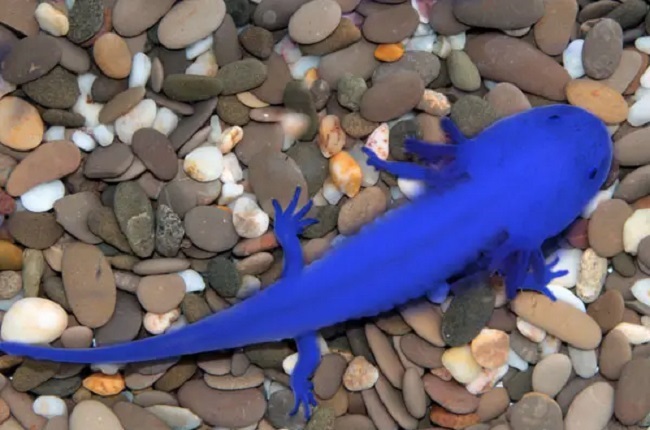The Blue Axolotl, also known as the Black Melanoid Axolotl, is a captivating aquatic salamander species that has gained popularity among exotic pet enthusiasts.
If you’re considering adding a Blue Axolotl to your home aquarium, it’s important to understand their specific needs and care requirements.
In this comprehensive guide, we’ll provide you with detailed information and care tips to ensure the health and happiness of your Blue Axolotl.

Characteristics of the Blue Axolotl
The Blue Axolotl, characterized by its dark black melanoid coloration, is a unique variant of the Axolotl species. Here are some key features of the Blue Axolotl:
Coloration: The Blue Axolotl has a uniform black coloration, lacking the typical pink or white pigmentation seen in other Axolotl variations.
Gills and External Gills: Like all Axolotls, the Blue Axolotl retains its larval features into adulthood, including external gills that protrude from the sides of its head.
Size: Blue Axolotls can reach an average length of 9 to 12 inches (23 to 30 cm) when fully grown.
Lifespan: With proper care, Blue Axolotls can live for approximately 10 to 15 years.
Tank Setup and Requirements
Creating a suitable habitat is essential for the well-being of your Blue Axolotl. Here are some important considerations for tank setup:
Tank Size: A minimum tank size of 20 gallons is recommended for a single adult Blue Axolotl. Larger tanks provide more swimming space and accommodate additional Axolotls if desired.
Temperature and Water Conditions: Blue Axolotls prefer cooler water temperatures between 60 to 68°F (15 to 20°C). Maintaining proper water conditions with a pH level of 6.5 to 7.5 is crucial for their health.
Filtration and Water Flow: Use a gentle filtration system to avoid creating strong water currents that may stress the Axolotl. Sponge filters or canister filters with adjustable flow rates are ideal.
Substrate: Choose a soft substrate like sand or fine gravel to prevent any injury to the delicate skin of the Axolotl.
Feeding and Nutrition
Blue Axolotls are carnivorous and require a diet consisting of high-quality protein-rich foods. Here are some feeding guidelines:
Live and Frozen Foods: Offer a variety of live or frozen foods suitable for Axolotls, including earthworms, bloodworms, brine shrimp, and small feeder fish. Ensure the food is appropriately sized for the Axolotl’s mouth.
Feeding Frequency: Feed your Blue Axolotl 2 to 3 times per week, adjusting the portion size based on their appetite. Remove any uneaten food to maintain water quality.
General Care Guidelines
To provide the best care for your Blue Axolotl, keep the following tips in mind:
- Water Quality: Regularly monitor water parameters such as temperature, pH levels, and ammonia, nitrite, and nitrate levels. Perform partial water changes as needed to maintain optimal water quality.
- Lighting: Blue Axolotls are sensitive to bright lighting. Use subdued or dim lighting in their tank to mimic their natural habitat.
- Handling: Minimize handling of your Blue Axolotl as much as possible to prevent stress and injury. When necessary, use gentle techniques and support the Axolotl’s body properly.
Conclusion
In conclusion, the Blue Axolotl, or Black Melanoid Axolotl, is a captivating aquatic creature with unique characteristics.
By providing a suitable tank setup, feeding a nutritious diet, and maintaining proper water quality, you can ensure the well-being and longevity of your Blue Axolotl.
Remember to monitor their health regularly, seek veterinary care when needed, and enjoy the fascinating experience of keeping this remarkable species as a pet.
























